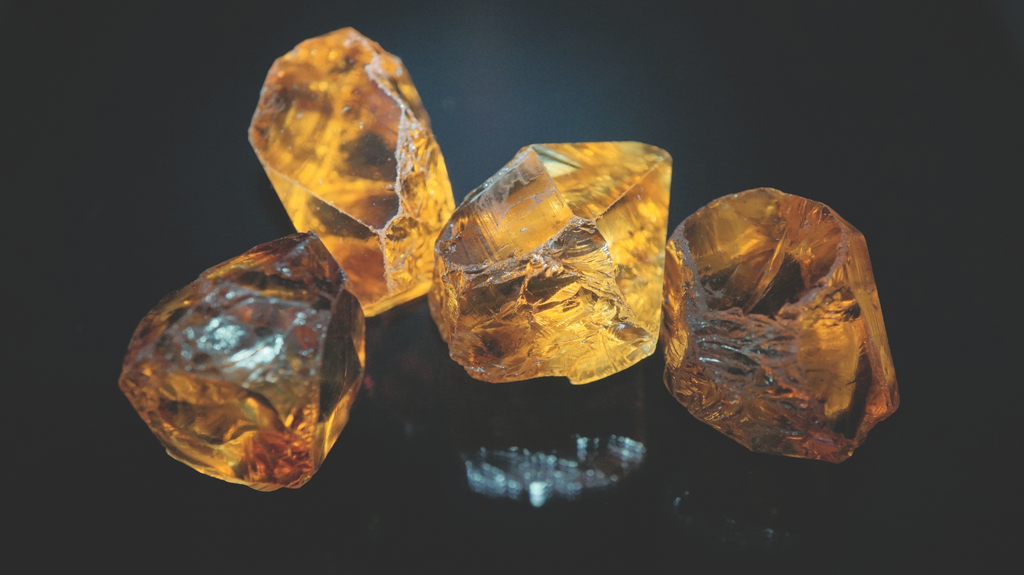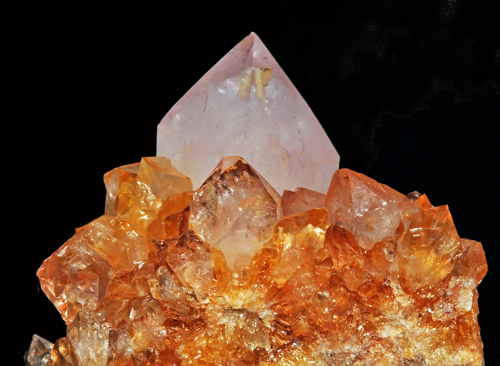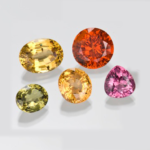Believed to carry healing properties of the sun
The yellow type of quartz known as Citrine Gemstones gets its name from the Old French term meaning lemon. This warm-colored gemstone, which is believed to be a gift from the sun, is the ideal way to add some color to an otherwise gloomy November month. Since ancient times, citrine has been a well-liked ornamental gemstone. Given their striking similarity to yellow topaz, it is not unexpected that both of these November birthstones have a history of being mistaken for one another and are believed to possess comparable abilities. Some people view citrine as a healing gemstone because it is reassuring, peaceful, and tranquil.
This phrase suggests a popular belief that citrine, a gemstone, is thought to possess healing qualities associated with the sun. It implies that wearing or having citrine nearby is believed to have a positive impact on both physical well-being (body) and emotional or spiritual wellness (soul). The notion draws a connection between the gemstone and the revitalizing attributes often associated with sunlight, symbolizing a source of positive energy and restoratio
What is Natural Citrine Gemstone?
Natural citrine is a yellow to golden-brown quartz type that is highly valued for its purity and warm colours. Natural citrine, which is comparatively uncommon in nature, gets its color from residues of iron, unlike heat-treated amethyst or smokey quartz.
Citrine Gemstones Health Benefits
Citrine is thought to provide a number of advantages for mental and physical health. In addition to enhancing mental clarity and concentration, immune system support, energy levels, positive perspective, and emotional balance, it can also improve mental clarity and focus.
Citrine is associated with the Solar Plexus Chakra and is beneficial to the midsection. It helps with constipation by supporting the kidneys, pancreas, spleen, adrenal glands, ovaries, testes, lower back, stomach, and digestive system.
When utilized in massage treatment, citrine can complement the effects of essential oils. It relaxes muscles, enhances circulation, skin tone, reduces cellulite, and may help cure sleep apnea and other sleep problems.
Five Different Citrine Gemstones Types
Citrine is a kind of quartz, and it goes by several names depending on what hue it is. Here are some of the more well-liked types:
golden sitrine
Golden citrine has a rich, warm gold tone and is slightly deeper in color than yellow citrine. This species is prized for its vivid, golden tones and is also widely used in jewelry.
yellow citrine:
Distinguished by its vivid, transparent yellow hue, this is the most prevalent kind of citrine. It is valued for its bright tint and is frequently used in jewelry.
madeira citrine:
Named for the Madeira wine, Madeira citrine is characterized by a rich reddish-orange to brownish-orange hue. Because of its deep, rich color, it is one of the most prized varieties of citrine.
fire citrine:
Fire citrine is distinguished by its blazing orange and red tones, frequently exhibiting a color gradient that resembles flames. Because of its strong and distinctive coloring, this variety is extremely rare and in high demand.
citrine palmeria:
This kind of citrine is well-known for its wide spectrum of colors, which frequently include tones of deep orange to pale yellow. The fact that it is named after a particular mine or area suggests that it has a special quality or source that makes it stand out from other varieties of citrine.
Take note: Citrine is not lemon quartz! Real Lemon Quartz is just quartz that has been exposed to radiation in order to give it a pleasing lemon hue.
As a result of its distinct charms and appreciation for their own colors and qualities, citrine is a popular and adaptable gemstone in the jewelry industry.
Characteristics of Natural Citrine
- Color: Yellow, golden-brown, to reddish-orange.
- Luster: Vitreous (glassy).
- Transparency: Transparent to translucent.
- Hardness: 7 on the Mohs scale.
- Structure: Hexagonal crystal system.
Uses of Natural Citrine Gemstone
- Jewelry: Natural citrine is a popular material for bracelets, rings, necklaces, and earrings, among other pieces of jewelry. Any object gains warmth and elegance from its bright color.
- Decorative Items: Applied to decorative artifacts and sculptures.
- Healing: It is a common option in crystal healing procedures since it is thought to have metaphysical qualities.
Benefits of Natural Citrine
- Prosperity and Abundance: Citrine, sometimes referred to as the “Merchant’s Stone,” is said to draw success and money.
- Joy and Positivity: Designed to lessen bad energy and encourage happiness.
- Energy and Vitality: Linked to increasing vitality and fostering creativity.
Regarding its color:
Citrine is a transparent gem with shades ranging from pale yellow to brownish orange. In the past, people often confused it with topaz due to its tawny color. Nowadays, the most popular citrine shades are earthy deep brownish or reddish-orange tones. The best citrine color is a vivid yellow to reddish-orange without brownish undertones.
When it comes to clarity, citrine usually doesn’t have visible inclusions, and if any are present, they can lower its value.
Citrine is like the yellow version of purple Amethyst, and they’re very closely related. The only difference between them is how much their iron impurities have oxidized.
Citrine is a type of quartz. Quartz is the second most common mineral in the Earth’s crust. It consists of silicon and oxygen and is found in all types of rocks. Other common types of quartz include amethyst, blue quartz, cactus quartz, chalcedony, rose quartz, and smoky quartz. Crystals form when liquids cool within rock cracks, and if certain minerals get trapped together, they can create colored crystals.

Sources citrine gemstones:
Citrine is found all over the world, however some of the main places to find it include the United States, Brazil, Uruguay, Madagascar, Russia, and Spain. Brazil is one of the world’s top producers of citrine, especially in the state of Rio Grande do Sul. Significant amounts of this gemstone are also supplied by Uruguay, particularly in the Artigas area. The Ural Mountains in Russia are another important source of citrine, while Madagascar is well-known for its distinctive shades. Spain is a major supplier of citrine to Europe, while significant citrine resources may be found in the US in areas like Colorado and North Carolina. Because of the area’s well-known citrine mines, there will always be an abundance of this exquisite yellow quartz.
As for treatments:
Heat treatment is a common method used to improve the color and clarity of citrine gemstones. As long as it is stated, this procedure is generally acceptable and has no effect on the stone’s value. When buying citrine, it’s important to exercise caution though, as some stones may have been coated or dyed to change their look. The gem’s long-term beauty and durability may be affected by these procedures. It is generally advised to buy citrine from reliable vendors who can give specific details regarding any processing the stone may have undergone.
How is citrine formed?
Two of the most prevalent elements on Earth, silicon and oxygen, combine to form citrine, a kind of quartz. Citronelle, like its sibling quartz, amethyst, is found inside geodes all over the world. Bubbles trapped in lava or volcanic rock give rise to geodes. There is a hollow inside when the exterior rock solidifies into an oval or round form. This void fills with liquids that are rich in iron and silicon dioxide over millions of years, and these liquids eventually crystallize into the quartz that is known as citrine. The diameter of these geodes can vary from a few millimeters to a size that can accommodate many persons climbing inside!
Is it possible for Citrine to change color?
In certain lighting situations, certain jewels display an amazing color shift. A color-changing garnet, for example, can seem red in artificial light but turn green in direct sunshine. Gemstones with this unusual and distinctive effect include alexandrite, color-changing sapphires, and color-changing garnets.
Citronelle, on the other hand, is not included in this group of stones that change color. While some citrine can change color when heated, extended exposure to sunshine can cause citrine to lose color. Thus, in order to preserve the vivid color of your citrine jewelry, it’s best to avoid lengthy sun exposure.
Care and Cleaning:
It’s essential to take good care of your citrine jewelry to guarantee its longevity and beauty. Due of its hardness, citrine may both damage softer stones and cause scratches to tougher jewels like diamonds or sapphires. To avoid scratches, keep citrine apart from other stones in distinct cloth bags or a compartment lined with fabric. Take off your jewelry before engaging in any strenuous activities that may expose citrine to damage, such as gardening or home cleaning. For a secure and efficient cleaning, use warm, soapy water and a gentle brush, like a toothbrush, on citrine. Use caution while using ultrasonic cleaners, particularly if the citrine has been treated or colored, or if treatment details are unclear. Furthermore, avoid using steam cleaners on citrine as the strong heat may harm the Gemstones.
FAQs about Natural Citrine Gemstones
Natural citrine is generated in the soil naturally; it is not colored by heat treatment applied by humans. Traces of iron give it a yellow to golden-brown shade.
Use a gentle brush and mild soapy water to clean natural citrine. Steer clear of direct sunlight for extended periods of time as this might fade the color. To avoid scratching, store apart.
The coloring of natural citrine often ranges from pale yellow to golden, with a more consistent distribution of color. Heat-treated amethyst, on the other hand, might have redder-hued, more vibrant tones.
It is thought that citrine draws happiness, prosperity, and good vibes. It’s also supposed to eliminate bad energy, increase confidence, and foster creativity.
Countries including Brazil, Madagascar, Russia, and the US are important suppliers of natural citrine.






